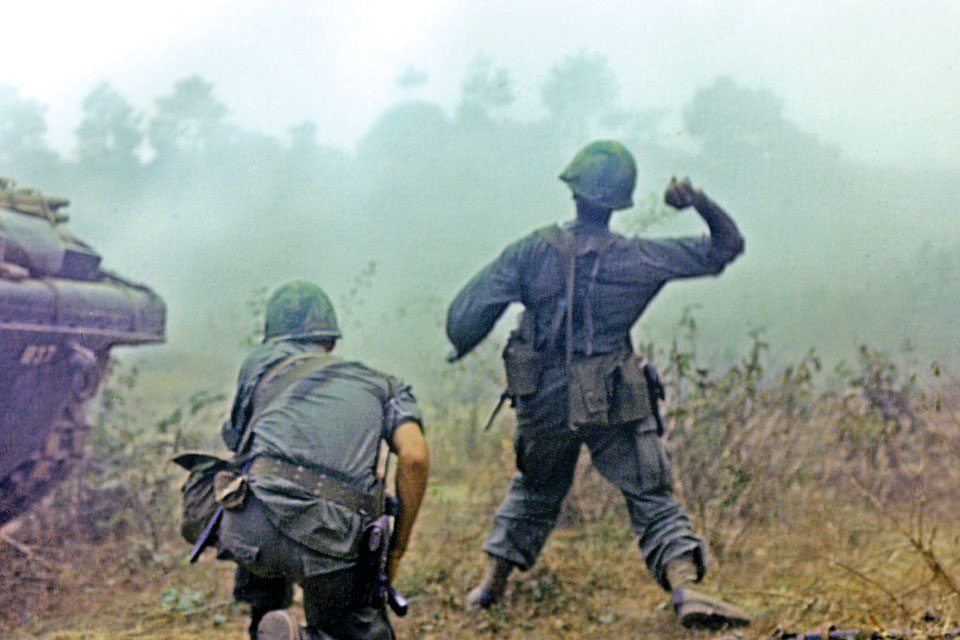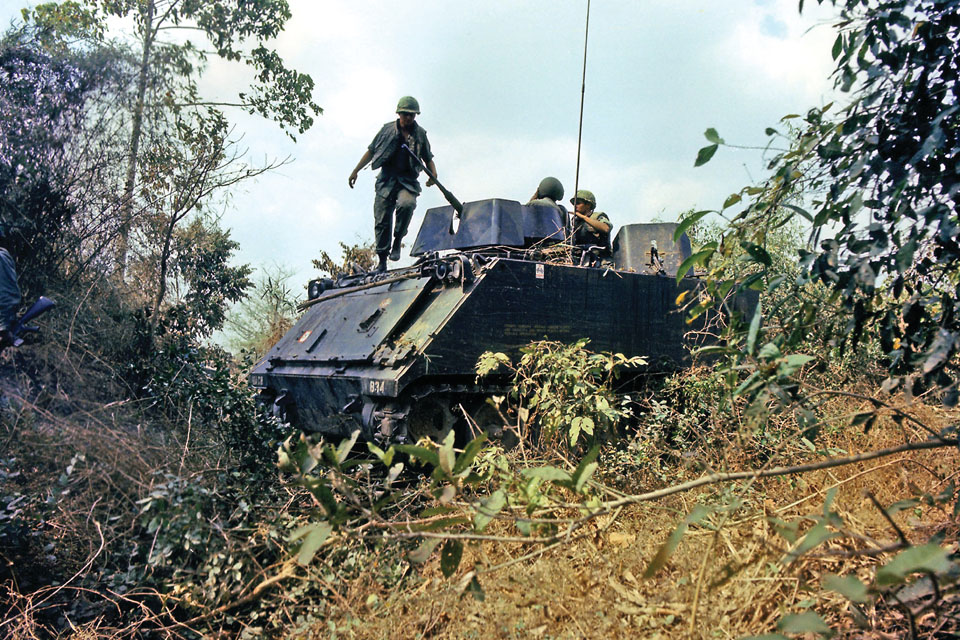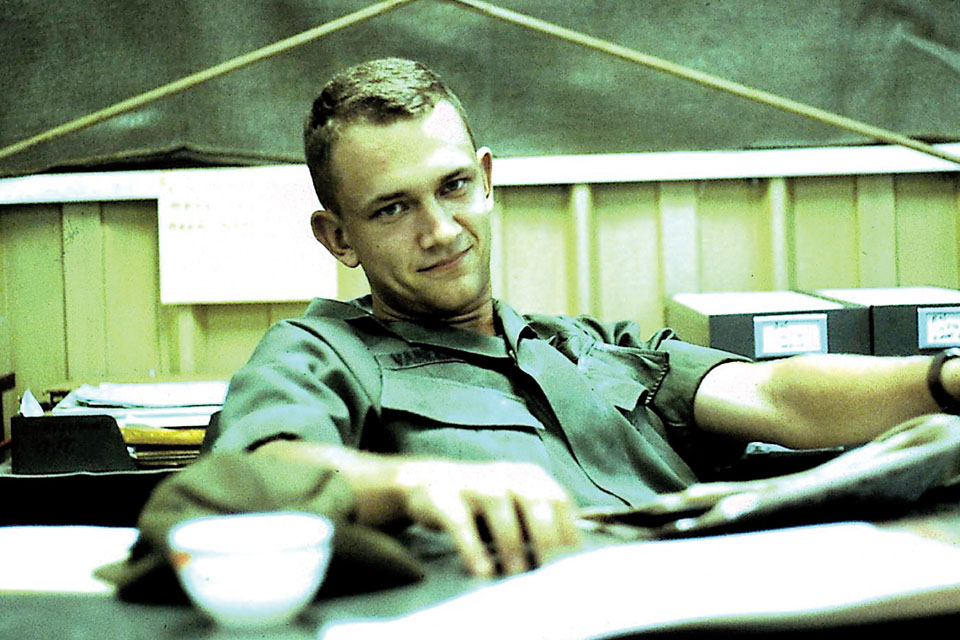It was another hot February day in 1969 at the sprawling Long Binh logistics base about 20 miles northeast of Saigon. My driver arrived at the usual time, a little before sundown, on Feb. 22, for my 12-hour graveyard shift at the 1st Logistics Command headquarters. (I was a big-shot first lieutenant and chauffeured to work.) I immediately detected signs that all was not right.
Behind the driver, strewn about the passenger seat and floor, was his personal combat gear, including his M14 rifle and several magazines filled with ammunition. With usual soldier directness the driver divulged the ominous news: “Sir, we’re gonna get hit tonight, so you’re gonna need your helmet, flak jacket and rifle.”
Not A Typical Day At Work
A Viet Cong deserter had warned South Vietnamese officials on Feb.19 that an attack would occur on Feb. 22, but Long Binh didn’t get the word until the day of the planned assault. The attack was expected to come on the ground, as opposed to those occasional, more impersonal rocket and mortar shells from the air. This attack was going to be a “big one.”
This was a bit disconcerting. It isn’t every day one peaceably sets off for work knowing someone is intent on one’s personal demise. The Long Binh/Bien Hoa complex was huge, with thousands of soldiers and airmen assigned to the combined logistics complex and air base.
The enemy would occasionally probe us, rocket us, mortar us and more than likely sometimes even shop at our PXs, but a ground attack? The idea seemed absurd! Surely neither the Viet Cong nor North Vietnamese Army would attempt such a suicidal mission.
The two huge U.S. bases dripped firepower—dozens of batteries of field artillery, large calibers and small, rows and rows of helicopter gunships and jet fighters loaded to the gills with the most lethal ordnance the world has ever seen, dozens of M113 armored personnel carriers with powerful .50-caliber machine guns manned by surly military police, and, of course, hundreds of trigger-happy clerks and truck drivers, not necessarily eager, but most definitely ready, for action.
The Road To Vietnam
Perhaps a word of explanation is in order on how I and all the others in our mix of volunteers and draftees ended up in this hot, smelly, unsafe corner of the world. Some of my first recollections as a youngster from the cornfields of Iowa were the television and radio presentations of an ominous phenomena known as the “yellow peril,” although on our black-and-white TV sets this threat appeared more as black swaths oozing first from Russia across China, then over North Korea and finally covering the countries of Southeast Asia on their way across the ocean to the United States. You can imagine how frightful that was to the mind of a 6-year-old.
On top of that came the domino theory of 1954, invented by then-President Dwight D. Eisenhower. Ike originally intended these dominos to represent China’s neighbors such as North and South Vietnam, Laos, Cambodia, Thailand and Malaysia, but it was not long before some believed that places like Cuba, Angola, Chile, Peru, Michigan and South Carolina would also be on the list.
The threat of communism was pounded into our heads all through elementary and high school at Rock Valley, Iowa.
Later I enrolled as an ROTC student at South Dakota State University, became an Army officer and was assigned to Long Binh in August 1968.
The Army always tries to capitalize on a soldier’s individual strengths. In my case it was my unusual ability to count. Thus, my daily mission (with the aid of my eight-man crew) was to account for all the ammunition in South Vietnam, at least every round not yet in the hands of the fighting troops. So proficient had I become at this task that I had acquired the nickname “Lieutenant Bullets.” Officially, however, I was an ammunition stock control officer in the Army Ordnance Corps.
For months I observed various combat actions outside the perimeter and every now and then even sought cover beneath a nearby steel desk as a stray mortar or artillery round came flying in our direction, which, whenever it occurred, was astonishing enough.
But now the tough Viet Cong and North Vietnamese Army itself were coming.
“Lieutenant Bullets” Prepares for Battle
Grabbing my helmet and flak jacket (and finding that, after sitting on the shelf for several months, neither would fit properly), I departed with my Jeep driver for the Logistics Command’s large yellow headquarters building. For my personal defense, I relied upon a somewhat rusty M16 kept around the office. Some of our troops had recaptured it from the VC a few months before. The rifle was accompanied by a single magazine of tracer rounds—bullets treated with a chemical that creates a trail of light when fired.
Once my eight-man crew of ammo counters had assembled, we set aside our usual duties and made the best preparations we could to survive the night. Thoughts now turned to what we should do if we came face to face with the enemy.
Combat training for ordnance officers at best is rudimentary. The basic course at Aberdeen Proving Ground in Maryland allocated one week “in the field” for brushing up on combat skills. Interestingly, the only thing that came readily to mind was a small sign I discovered at one of the outdoor latrines set back in the woods: “ALL TERDS [sic.] OVER 30 POUNDS IN WEIGHT MUST BE LOWERED BY ROPE.” With no clear idea of what to do in combat, I would have to improvise.
As darkness approached some comfort was provided by the constant sweeps outside the perimeter made at treetop level by the guys in their little OH-6 “Loach” light observation helicopters. Apparently, not much was out there, as there was no firing to speak of. I visited my friends down the hall in the almost deserted headquarters building, but mostly kept up my vigil of the activity outside the perimeter, which, as darkness descended, now included an occasional flare.
Enter the Mortars
All was relatively quiet until approximately 11:30 p.m., when suddenly a string of 82 mm mortar rounds “marched” directly across our end of the headquarters complex. The first explosion, seemingly an earth-shattering blast, occurred perhaps 30 or 40 yards outside our office, spraying the building with gravel and steel fragments, perforating our walls and windows.
As usual, I initially took refuge under my desk, then ordered everyone to rush downstairs on the assumption that any direct hits would likely riddle the upper floor. We had no bunkers.
Things quieted down for a while. Soon we received word that every spare man was to report for perimeter duty, and within minutes my entire crew had been spirited away, leaving me to fend for myself. Since the headquarters building stood out on the hill like a large bull’s eye, I proceeded outside and took up a defensive position behind a corner of our building, on the safe side. From there, I had a good view of the perimeter and the rapidly unfolding battle.
Shortly before midnight the entire perimeter “lit up” with machine gun fire. The battle area was quickly illuminated by large spotlights supplemented with dozens of flares fired by our artillery. The panorama took on an aspect of “high noon,” the entire battlefield bathed with an eerie golden glow. The firing grew to a continuous roar, with lines and lines of red tracers emitted by M60 machine guns crisscrossing the battlefield.

Then came a sound akin to that of large paper sacks tearing, as AH-1 Cobra helicopter gunships began strafing the battlefield with 7.62 mm minigun bullets fired at the rate of about 4,000 rounds per minute. A three-second burst would saturate an area the size of a football field. The miniguns fired four rounds of invisible “ball” bullets followed by one tracer round, but the bullets came so fast they looked like a continuous red stream. Many of the tracers bounced off the ground like rubber balls.
Nobody To Be Seen
With no friendly troops visible between me and the battle, into my M16 went the magazine of tracers in preparation for a confrontation with anyone who might break through that wall of gunfire, something at which the Viet Cong were quite adept. After years of Army training one cannot help but itch for a “shot” at the enemy, especially when all the advantages are on one’s own side. As Ole-Luk-Oie, the pen name for British officer Ernest Swinton, wrote in the 1915 book The Great Tab Dope: “Who can blame a desire for the ‘real thing,’ or professional zeal, whether it be that of a burglar, a Harley Street appendix hunter, or a trainer of blind monkeys?”
My hope was that no more than one or two VC would reach my position. And that they would already have been shot three or four times before they got there. Amazingly five or six Viet Cong actually did sneak into the compound, but, luckily or unluckily for my sake, depending on the outcome, not in my area.
With the progression of the battle came a feeling of incredulity. We were being attacked by at least a full enemy battalion in a fight raging with remarkable intensity. The battle area had been cleared for at least 500 to 1,000 yards from the perimeter—all foliage and any source of cover had been bulldozed flat. And yet there was nobody, absolutely nobody, visible out there. Except for the eruptions from our perimeter bunkers, the entire battlefield seemed devoid of people—at least people who could be seen.
I was experiencing what soldiers for more than half a century referred to as the “empty battlefield.” Modern battlefield weapons had become so lethal that to expose oneself, even for an instant, to their fire was tantamount to suicide. It was nothing like what I saw in my imagination or what is shown in movie theaters or on television.
I must add, though, that from a different perspective the battle I witnessed in Vietnam was exactly the same as those I had seen in movies: One was just as unreal as the other.
Apparently, it was impossible for an Iowa corn farmer to get his mind around the idea of hundreds of men actually trying to kill each other.
I don’t think I was alone in this. Filmmaker Mel Brooks once said he looked upon his Army experience in World War II as a “newsreel.”
At approximately 3:30 a.m. on Feb. 23, the battle gradually died out. One of the larger battles of the Vietnam War had been fought right in front of me, and I never saw the enemy. Later I learned that we were attacked by the 274th Regiment, 5th Viet Cong Division, which was repulsed by the firepower of the 720th Military Police Battalion, the 18th Military Police Brigade and helicopter gunships from the 145th Aviation Battalion, 1st Aviation Brigade.
I heard that five American soldiers were killed and some 30 wounded. Most estimates put the Viet Cong deaths at over 100. Once the sun came up, a troop of the 11th Armored Cavalry Regiment found 139 dead enemy soldiers, Stars & Stripes reported.
Tunnels—An Unpleasant Suprise
After the battle came another shock. The cavalry troopers also stumbled onto a large tunnel complex not more than a mile from our perimeter. The Viet Cong had constructed some sort of headquarters compound, or staging area, or supply depot or maybe even an officers’ club. Unlike our headquarters, theirs was built under a hill rather than on top of one.
We had a perfect view of the VC hill, and it slowly began to dawn on me that for the past seven months, as each evening’s shift began with my casually scanning the quiet hills to the south and southeast of Long Binh, there was a fair probability I was being scanned right back—likely by some VC ammo counter busily inventorying his AK-47 bullets, 122 mm rockets, 82 mm mortars and B-40 rocket-propelled grenade rounds, while I counted M16 bullets, Claymore mines and howitzer shells. The idea was quite unsettling.
The Viet Cong were no longer in the tunnels around Long Binh, most probably having taken the subway back to the main tunnel complex at Cu Chi. Sixteen bulldozers were quickly deployed to spend the rest of the day sealing the entrances.
Well, not everybody had departed. An injured North Vietnamese soldier fighting with the Viet Cong, Pvt. Tran Van Thiet, 19, had been left behind. He had a serious leg wound and was evacuated to the field hospital across the street from my barracks.

Tran, who was from the Haiphong area of North Vietnam, had high expectations for a victory in the attack, according to an interview in Stars and Stripes. A regimental “commissar” had assured the men in Tran’s company that “the attack would be easily successful and after it was over we would be able to go home to North Vietnam.” The rationale given for the supposedly easy victory: The VC battalion would face only “desk soldiers” without field experience (ouch!).
The Enemy Actually Wanted C-Rations?
There was another motivation for Tran as he attacked the American base. He was told his unit would capture “many C-rations.” Food was always a dominant concern for the habitually starved Viet Cong. In anticipation of what they would seize, many of Tran’s comrades packed can openers in addition to the noodle packets and dried rice they all carried. These ingredients—when mixed with the C-ration “Beef, Spiced with Sauce” or the “Beans w/ Frankfurter Chunks in Tomato Sauce”—would have provided the Viet Cong a feast for the ages.
On the other hand, one is left to ponder what affect seeding the battlefield or, even better, seeding the Ho Chi Minh Trail itself with C-ration packets of the despicable “Ham and Lima Beans” might have had. Is it possible Tran and his friends would have simply elected to return to North Vietnam and forgotten the idea of an attack on Long Binh altogether?
Tran’s primary motivations seem quite similar to our own: eating and getting home. As far as political considerations go, he hardly seemed interested in building a communist utopia at all.
—Jim Van Eldik is a retired Army lieutenant colonel. He was discharged from active duty after his Vietnam tour and shortly afterward was assigned to an Army Reserve unit. He went back on active duty in 1983 and retired in 1995.
Published in the October 2017 issue of Vietnam magazine.





